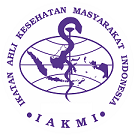Analysis of Inputs in the Sexually Transmitted Infection Screening with Voluntary Counselling and Testing Program for Female Prisoners at Class II A Jail, in Malang
Abstract
Background: The increasing incidences of Sexually Transmitted Infection (STI) and Human Immonodeficiency Virus (HIV) infection are becoming serious public health concerns in Indonesia and other countries. These issues are of concern that call for close attention not only for general public but also for male and female prisoners. As studies have shown the prevalences of HIV and syphilis were 1.1% and 5.1% in male prisoners, respectively, 6% and 8.5% in female prisoners. For those reasons, at some jails Voluntary Counseling and Testing (VCT) have been provided for HIV/AIDS control and prevention. The success of the screening program with VCT would depend on the provision of supplies, equipment, infrastructure, health personnel, and fund. This study aimed to analyze the adequacy of various inputs in the STI screening program with VCT for prisoners at the Class II A female jail, in Malang, East Java.
Subjects and Method: This was a qualitative study with evaluation approach. This study was conducted at the Class II A female jail, in Malang, East Java. The study applied CIPP (Context, Input, Process, Product) evaluation model. Key informants for this study included health personnels at the Class II A female jail clinics, in Malang, East Java, the STI mobile health care team from Arjuno Community Health Center Malang, and female prisoners, who were known as Warga Binaan Pemasyarakatan (WBP)
Results: Average monthly visits at the VCT clinic were 21 female prisoners, which amounted to only a few of the total number of female prisoners. The health care team involved in the STI screening with VCT program, included skilled health personnel from the jail and the mobile STI team from Arjuno Community Health Center, Malang. The sources of fund for these programs came from the international as well as domestic funding agencies. The international funding came from the Global Fund. The domestic funding came from the Ministry of Law and Human Civil Rights, and the Municipality Health Office Malang, which provided reagents and medicine. Supplies, equipments, and infrastructure, were provided by Arjuno Community Health Center Malang and the Class II A female jail clinics, in Malang. The laboratory was provided by the health center. The reagents were sufficiently provided by the municipality health office, although there was a supply delay in February 2016.
Conclusion: Inputs of the STI screening with VCT program at the Class II A female jail clinics, in Malang, East Java, which included supplies, equipment, infrastructure, health personnel, and funding, are sufficiently provided.
Keywords: analysis, input, screening, STI, VCT
Correspondence: Rosyidah Alfitri. Diploma III School of Midwifery, Dr. Soepraoen Hospital, Malang. Email: elfitri.mafaza@gmail.com.
Journal of Epidemiology and Public Health (2016), 1(2): 118-124
https://doi.org/10.26911/jepublichealth.2016.01.02.05
How to Cite
References
Cheng (2016). Late Presentation of HIV Infection: Prevalence, Trends, and the
Role of HIV Testing Strategies in Guangzhou, China, 2008–2013. Bio Med Research International, 7: 1631878
Díez, Díaz (2011). Sexually transmitted infections: Epidemiology and control. Epidemiology Department on HIV and Risk Behaviors. National Centre for Epidemiology. Health Institute Carlos III Rev Esp Sanid Penit; 13: 58-66.
Farsi M, Sharif M (2014). Stufflebeam’s Cipp & Program Theory: A Review. International Journal of Language Learning and Applied Linguistics World (IJLLALW) 6(3) : 400-406.
Idrus M (2008). Metode Penelitian Ilmu Sosial; Pendekatan Kualitatif dan Kuantitatif Edisi Kedua. Jakarta: Erlangga
Miles M, Huberman A (2014). Analisis data Kualitatif; Buku Sumber tentang Metode-Metode Baru. Jakarta: UI Press
Kebijakan Kesehatan Indonesia (2013). Konteks Kebijakan AIDS: Epidemiologi dan Perilaku Beresiko. [online]
Kementerian Kesehatan RI (2011). Pedoman Nasional Penanganan Infeksi Menular Seksual. Jakarta: Dirjen Pengendalian Penyakit dan Penyehatan Lingkungan.
Kementerian Kesehatan RI, Kementerian Hukum dan HAM RI (2012). Pedoman Pelayanan Komprehensif HIV AIDS & IMS di Lapas, Rutan dan Bapas. Direktorat Pengendalian Penyakit & Penyehatan Lingkungan Kemenkes RI dan Direktorat Pemasyarakatan Kemenkumham RI.
Rosena DL (2015). Op-tout HIV testing in prison: Informed and voluntary? AIDS Care; 27(5): 545–554.
WHO, UNODC and UNAIDS. 2007. Evidence For Action Technical Papers Interventions to Address HIV in Prisons Prevention of Sexual Transmission. Geneva.



1.jpg)








